Kererū Returns Home After 24 Years of Absence
The prolonged absence of a significant fauna element from its natural habitat invariably carries profound ecological consequences.
Such is the example of the Native New Zealand Pigeon (Hemiphaga novaeseelandiae), also known as Kererū or the New Zealand wood pigeon.
Which recently resurfaced after an alarming 24-year absence from its indigenous landscape.
This species, displaying an attractive plumage of metallic greens, blues and whites, has traditionally been a significant emblem of New Zealand’s unique avifauna.
Kererū is a quintessential figure in Indigenous Maori culture and critical to native forest regeneration. The pigeon was seemingly on the verge of exile from its host ecosystem.
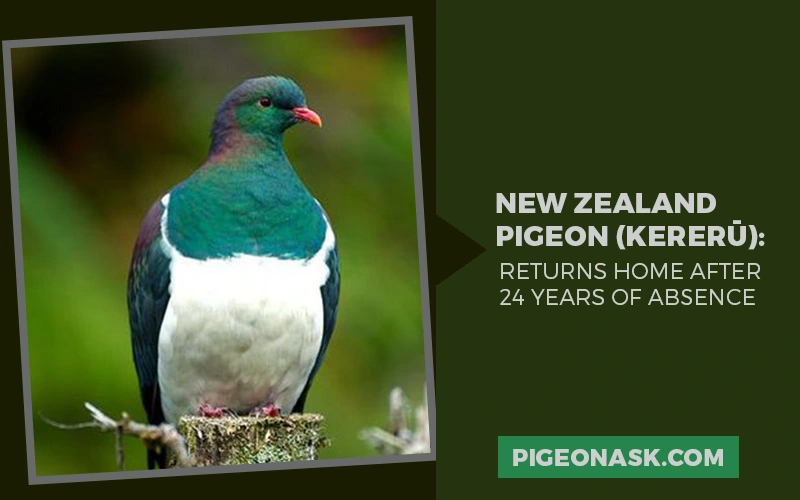
However, its surprise return after more than two decades not only presents renewed hope for biodiversity but also prompts an incisive re-evaluation of conservation strategies to preserve endangered species, such as the majestic Kererū.
The Enigmatic Native New Zealand Pigeon (Kererū)
The Kererū, also known as the New Zealand pigeon (Hemiphaga novaeseelandiae), holds a significant status in the mythology, culture and ecosystem of New Zealand.
This striking bird symbolizes the life force in the Māori culture.
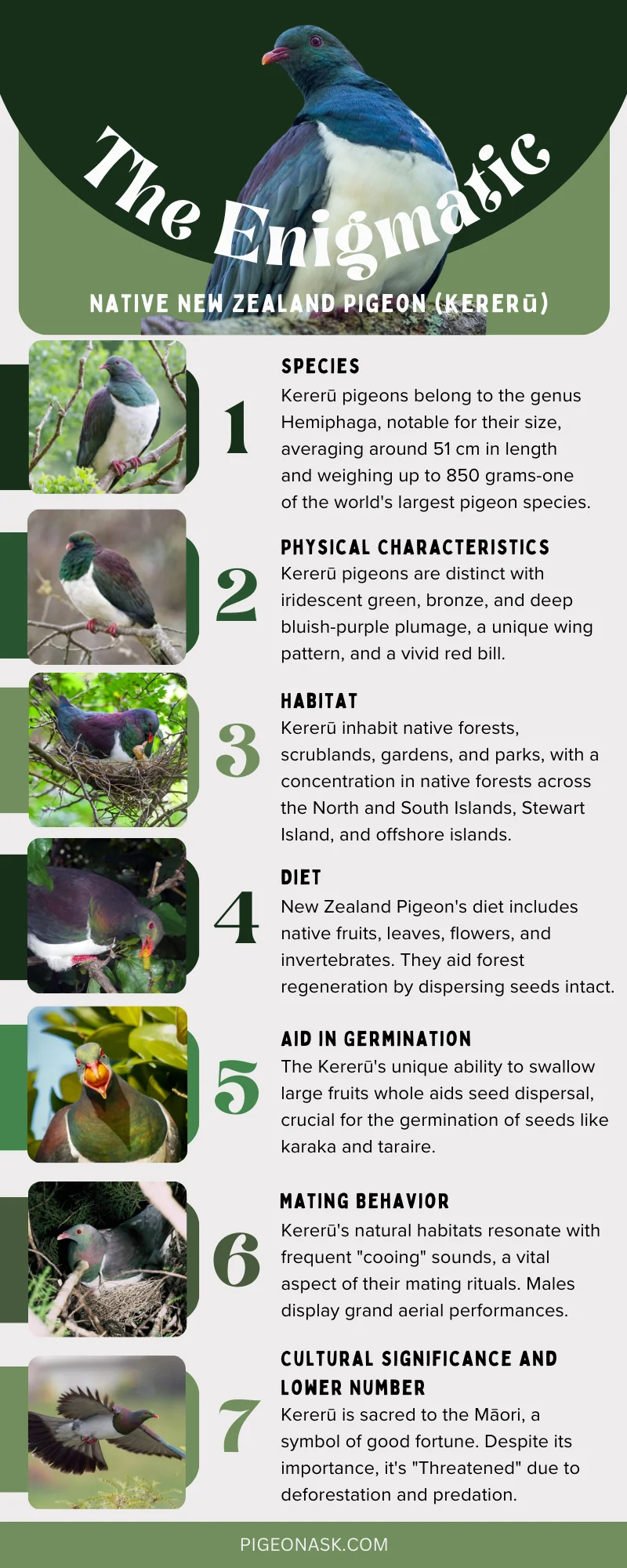
Species
Kererū pigeon’s species falls under the genus Hemiphaga.
They physically boasts an impressive size compared to other pigeon species, with an average body length of around 51 cm and a weight going up to 850 grams, making it one of the largest pigeon species globally.
Physical Characteristics
A distinctive and majestic appearance marks the bird. They have stunning colors: iridescent green and bronze feathers on their head, a white band on their lower chest and deep bluish-purple plumage.
The wings are folded in a unique pattern, creating a broad white band visible in flight, contributing to its beautiful, distinguishing features.
Bill of the Kererū is a vivid red with attractive, eye-catching, purplish-red, fleshy ceres. Their robust body and broad, rounded wings enable them to navigate carefully through dense forests and achieve fast yet quiet flight.
However, the bird is notably clumsy on the ground, taking off and landing. At a glance –
| Characteristic | Description |
|---|---|
| Plumage Coloration | Iridescent green and bronze on upperparts, white on underparts |
| Feather Patterns | Subtle rippling effect on head and neck, scalloping on wing coverts |
| Eye Color | Blood red |
| Beak Structure | Stout, straight-based, red color |
| Head Shape | Rounded with small, subtle crest |
| Legs and Feet | Sturdy, crimson red, strong grasping claws |
| Body Size | Up to 50 cm (20 in) long, 75 cm (30 in) wingspan, 550-850 g (19-30 oz) weight |
| Wing Shape | Broad, rounded, slightly tapered tips, white underwing feathers |
| Tail Length and Shape | Short (10 cm), broad, fan-shaped, iridescent green |
| Crest or Crown | Small, subtle |
| Neck Length and Thickness | Relatively long and slender, transitions from iridescent green to copper-sheened purple |
| Cere or Wattle | Absent |
| Iris Ring | Narrow, pale |
| Body Posture | Upright, relaxed, hunched when perched |
| Vent Area | White feathers, small and inconspicuous |
Habitat
Kererū can be found in native forests, scrublands, rural and city gardens and parks. However, they are most abundant in native forests.
They are typical in the North and South Islands, Stewart Island and many offshore islands.
Diet
The diet of the New Zealand Pigeon consists primarily of fruits from native trees. Among these are puriri, taraire, tawa and karaka, supplemented by leaves, flowers and small invertebrates.
The bird plays a crucial ecological role as it is one of the few animals capable of swallowing fruits of these trees whole and dispersing the seeds intact, aiding in forest regeneration.
Aid in Germination
A unique characteristic of the Kererū is that it’s one of the only birds capable of swallowing large fruits and berries whole.
This ability allows them to digest the pulp and excrete the seeds intact, often far from the original plant, thereby facilitating seed dispersal.
Some of the seeds, such as those from karaka and taraire, even require this process for germination. Without the Kererū, many native trees would struggle to reproduce naturally.
Mating Behavior
You can frequently hear resonant “cooing” sounds echoing through their natural habitats – a key part of their mating rituals.
In these rituals, males show grand displays, flying high in the sky, then plummeting downwards, only to swoop upwards again.
Cultural Significance and Lower Number
The Māori people hold the Kererū in high esteem and consider it as ‘tapu’ (sacred).
This bird is featured significantly in their mythology. Seeing the Kererū in the wild is considered a good omen by the Māori people.
Despite its cultural significance and ecological importance, the Kererū is classified as a “Threatened” species and listed in the IUCN Red List.
Their number declined due to deforestation, predation by introduced species like rats, stoats and possums and illegal hunting.
Various conservation efforts such as habitat preservation, control of introduced predators and public education are exerted to safeguard this iconic species.
Description of the Disappearance – Circumstances Leading to the Absence
In recent decades, the Kererū pigeon population has seen a substantial decline in its native habitats, leading to concerns about the species’ possible disappearance.
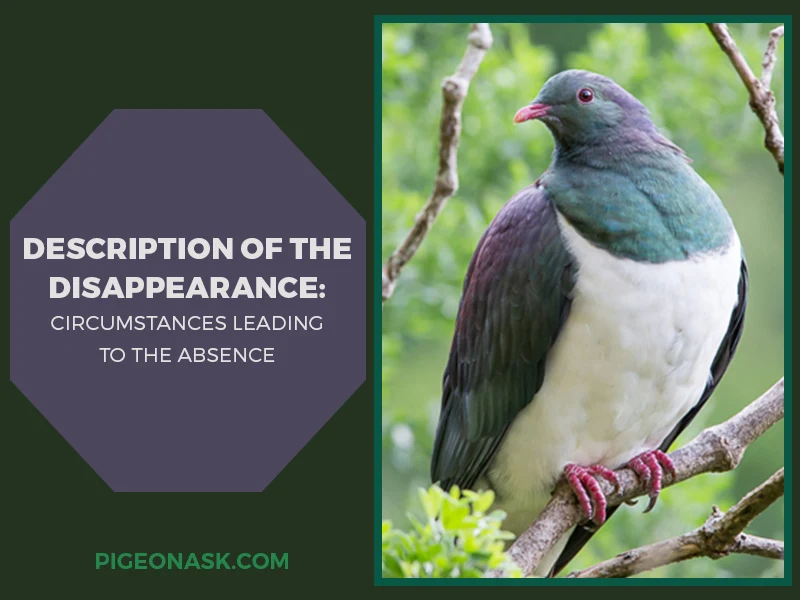
However, the Kererū haven’t completely disappeared, they are still prevalent, but their numbers have significantly reduced in their native habitat.
There are several factors attributed to the decrease in the Kererū population –
Habitat Loss
The most significant reason for the population decline of this bird is deforestation and habitat loss.
Wide-scale deforestation and land conversion for agricultural, commercial and residential use in New Zealand have led to the degradation and fragmentation of the Kererū’s natural habitat.
Kererū pigeons are frugivores (fruit-eating birds) and their diet mainly consists of fruits from native trees and leaves, flowers and small insects.
Deforestation is particularly devastating for Kererū, as it causes food scarcity and the loss of nesting sites, constraining the bird’s ability to reproduce, find shelter and survive.
Predation
The mammal predators such as stoats, rats and possums pose a significant threat to the Kererū by hunting the birds and their eggs. These pests were introduced by European settlers and preyed on Kererū eggs, young birds and even adults.
Non-native predators don’t have natural enemies in New Zealand, leading to an imbalance in the ecosystem and increased predation rates impacting the Kererū populations adversely.
A study conducted by The University of Auckland, New Zealand, found that strict control of introduced mammals increased the successful breeding of the Kererū pigeon.
Human Impact
The disappearance of Kererū pigeons has also been significantly impacted by human influence. Previously, Kererū were hunted for their meat and feathers, leading to a considerable decline in their population.
Though this practice has been legally stopped, there’s evidence of illegal hunting, which continues to pose a challenge.
Other human activities, including the creation of roads and traffic accidents, have also contributed to their declining numbers.
Slower Breeding Rate
The Kererū pigeon, renowned for its peculiar breeding rate, which is slower compared to other bird species, has been one of the leading factors contributing to its decline.
Their low reproductive rate, typically only one chick per year, puts the Kererū at greater risk of vulnerability.
Furthermore, high chick loss rates due to predation mean fewer Kererū pigeons reaching maturity, thus limiting the potential for population growth.
Lack of Foods
Food availability is another crucial driver of population shifts. Kererū, primarily herbivores, feed on leaves, flowers and native berries from New Zealand’s forests.
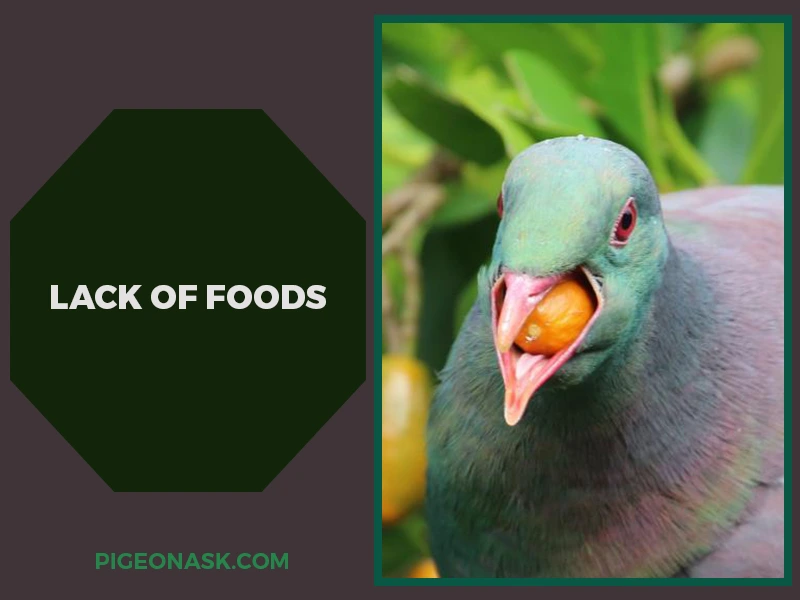
Unfortunately, human-driven habitat destruction, such as deforestation and conversion of natural environments to agricultural lands, has significantly reduced the availability of these vital food resources.
As a direct result, Kererū are often compelled to travel longer distances in search of food, thereby increasing their exposure to predators and reducing their energy reserves for successful breeding.
Climate Change
The impact of climate change presents a severe challenge to the Kererū population, radically altering its native habitat.
Rising temperatures, erratic weather patterns and increased frequency of extreme weather events are all environmental stress factors attributed to climate change.
These shifts can negatively impact the availability and quality of food resources, disrupt breeding patterns and lead to loss of suitable habitats, all of which pose a significant threat to the survival of the Kererū pigeon.
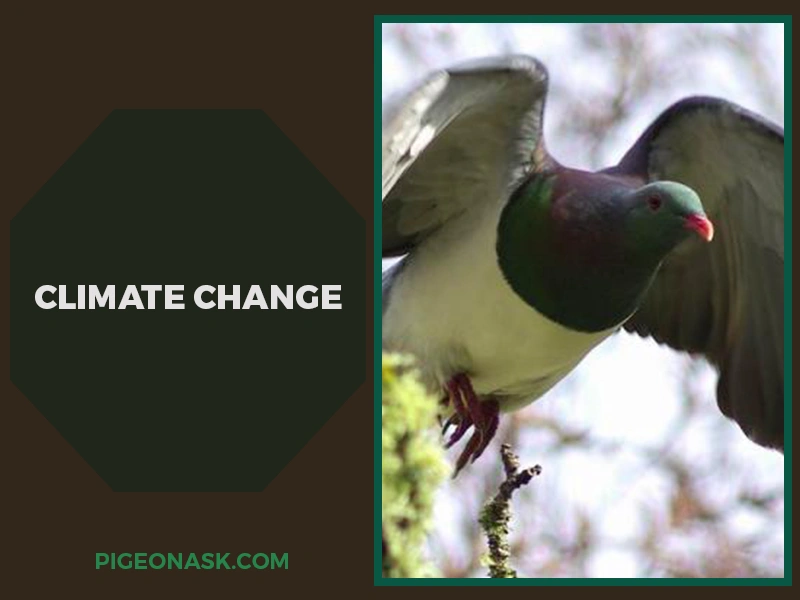
Government agencies and various organizations throughout New Zealand have recognized the importance of the Kererū and efforts are underway to protect and restore its population.
These initiatives include pest management strategies, habitat protection and restoration and public education. The annual “Great Kererū Count” helps monitor the population health of this species and offers researchers crucial data.
However, the road to recovery for the Kererū pigeon remains long and it will take considerable efforts to bring them back from the brink of disappearance.
The Astonishing Return – Reappearance of the New Zealand Pigeon
The New Zealand Pigeon was nearly on the point of extinction a few years ago.
Yet recently, there has been a remarkable resurgence in its population – a wildlife conservation success story that deserves recognition.
The astonishing return was first noted in suburban areas, parks and forests of New Zealand, especially around Wellington and Auckland.
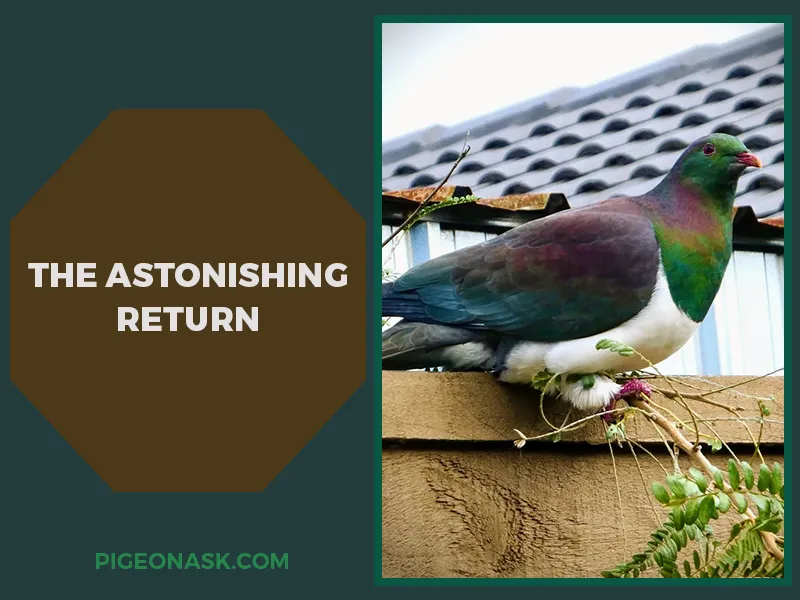
Residents, birdwatchers and wildlife enthusiasts initially reported an increase in sightings of a large bird with distinctive bright green and bronze plumage, a fan-like white chest and a loud clattering sound during flight.
These observations were subsequently confirmed by professional ornithologists and conservation workers, who had been monitoring its dwindling population for years.
However, several measures have contributed to their reappearance in their native habitats.
Conservation Programs
The New Zealand Department of Conservation is heavily involved in recent conservation efforts, creating a series of protected reserves that include viable habitats for the species.
They initiated a successful breeding program and implemented pest-control strategies to mitigate the threat of predation on the pigeon.
Community Participation
Initiatives for community conservation like the Kererū Discovery Project, which encourages citizens to report sightings of Kererū, have been instrumental in the bird’s recovery.
This public participation initiative has raised awareness about the pigeon’s plight and helps monitor its return across the country.
Kererū Count Program
The annual Great Kererū Count, New Zealand’s biggest citizen science project. Each year, thousands of people throughout the country participate in this collaborative event.
It’s an essential initiative to collect data on Kererū distribution and population trends, which enables more effective conservation strategies.
Regulatory Measures
Over-hunting was a significant factor contributing to the decline of the Kererū population. The New Zealand government took significant steps to regulate and prohibit hunting.
The Wildlife Act of 1953 provides full protection to Kererū, making it illegal to hunt or capture them.
Predator Control
Introduced predators like stoats, rats and possums have posed a significant threat to the Kererū.
Efforts have been made to control these predators’ populations, including trapping programs and, in some instances, the use of aerial 1080 poisoning – a contentious but effective method of controlling these pests’ numbers.
Habitat Restoration
Loss and degradation of native forest habitat also played a crucial role in the reduction of Kererū numbers.

Conservation programs have endeavored to preserve and regenerate their natural habitats, establishing protected areas that are safe reflections of their original living environments.
Public Awareness
Increased public awareness has also played a role in the recovery of Kererū populations. Initiatives such as the annual Great Kererū Count have enhanced public participation and interest in the conservation of these birds.
Rehabilitation and Release Programs
Injured or sick individuals are often taken into care by wildlife rehabilitation centers, who treat and care for these birds before they are released back into the wild. Such programs have contributed to boosting Kererū numbers.
Research
Ongoing research into the habits and needs of the Kererū has helped guide conservation efforts. Studies into their diet, habitat preferences and breeding habits have allowed for more directed and effective conservation strategies.
The Kererū’s Role in the New Zealand Ecosystem
Kererū pigeon plays a significant role in shaping the unique ecosystem of New Zealand. As an endemic species, it’s been an integral part of the country’s biodiversity, contributing to the dispersal of seeds from native flora.
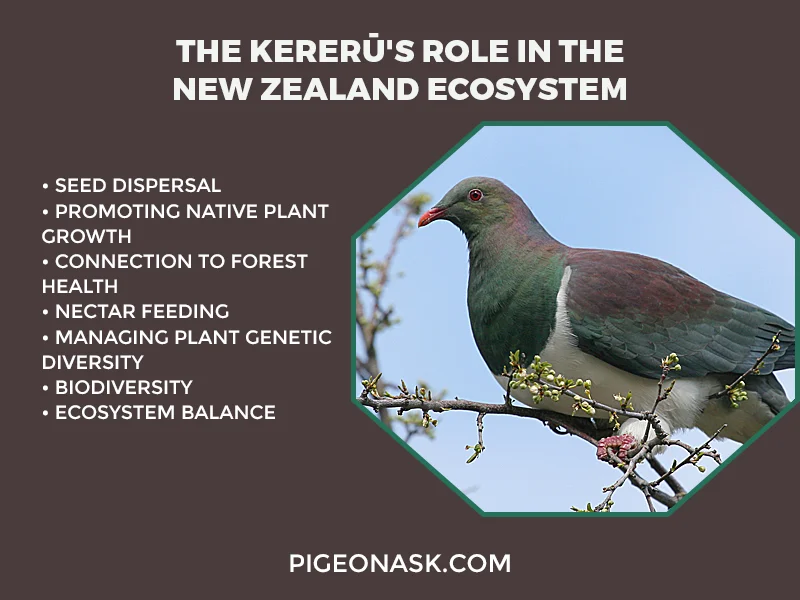
Here are some key aspects of the Kererū’s ecological role –
Seed Dispersal
Kererū are known as “the gardeners of the forest” because they are one of the few native bird species in New Zealand that can swallow and disperse the large fruits and seeds of many native trees and shrubs.
They can swallow and disperse the seeds of large fruiting trees such as taraire, tawa and puriri.
After consuming fruits, Kererū can fly over significant distances and when they excrete the seeds in their droppings, they help to disperse these seeds to new locations.
This process is essential for the regeneration and distribution of native plant species, contributing to the health and diversity of New Zealand’s forests.
Promoting Native Plant Growth
By facilitating the spread of seeds, Kererū aids in the growth of native plants and trees. This, in turn, helps to maintain the biodiversity and ecological balance of New Zealand’s unique forest ecosystems.
Connection to Forest Health
The presence and population health of Kererū can serve as an indicator of overall forest health.
A robust Kererū population suggests the availability of abundant fruiting trees and healthy ecosystems, while declining Kererū populations may signal ecological imbalances.
Nectar Feeding
In addition to fruit and seed consumption, Kererū also plays a role in pollination by feeding on nectar from native flowering trees and shrubs.
While they are not the primary pollinators for these plants, their visits to flowers can contribute to the pollination process.
Managing Plant Genetic Diversity
Kererū plays a role in maintaining the genetic diversity of the forest. By dispersing the seeds over large distances, the bird helps to mix the plant gene pool, which results in a healthier, more resilient forest ecosystem.
These birds also help control invasive plant species by feeding on their seeds and reducing their spread.
Biodiversity
A healthier Kererū population would help support the biodiversity of native plant species and the animals that depend on them. This has a positive ripple effect throughout the ecosystem.
Ecosystem Balance
Kererū’s role in dispersing seeds and promoting plant growth helps maintain ecological balance. This is crucial for the long-term sustainability of New Zealand’s unique ecosystems.
Impact of the Kereru Pigeon’s Return in New Zealand
Having faced serious threats to their population in the recent past, Kererū pigeon numbers have begun to recover thanks to extensive conservation efforts.
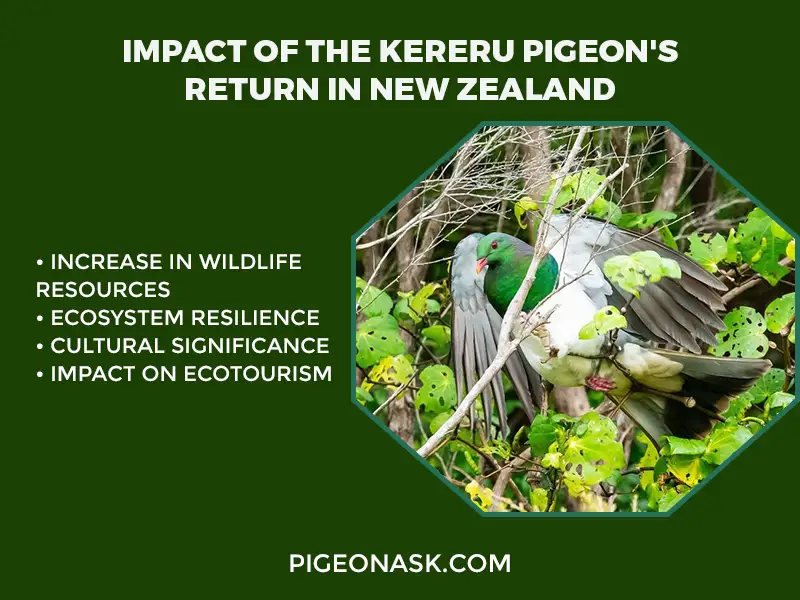
This resurgence of this pigeon has had significant effects on New Zealand’s ecosystems, culture and local communities. Here are some of the potential effects –
Increase in Wildlife Resources
A thriving Kererū population is often an indicator of a healthy forest ecosystem. The presence of these pigeons can signal the availability of fruiting trees, which, in turn, supports other native wildlife that rely on these resources.
Ecosystem Resilience
A healthy Kererū population could contribute to the resilience of New Zealand’s ecosystems in the face of climate change and other environmental challenges.
Their role in seed dispersal it is that they are the only bird in New Zealand large enough to swallow and disperse large fruit seeds.
Some native tree species in New Zealand relied solely on the Kererū for seed dispersal, thereby making this bird species critical for forest regeneration.
Therefore, the return of the Kererū is extremely beneficial for the biodiversity and health of New Zealand forests.
Cultural Significance
Kererū is culturally very important in New Zealand, particularly to Māori people.
The bird is considered a ‘taonga’ or treasure. Its feathers are used in traditional Māori clothing and adornments, while its image features prominently in art, legends and folklore.
The return of the Kererū is thus seen as a conservation success and holds significant cultural meaning for New Zealanders.
Impact on Ecotourism
New Zealand’s ecotourism industry and nearby towns have benefited from the Kererū’s comeback.
Birdwatching is a popular activity and the sighting of the magnificent Kererū pigeon can draw tourists to certain regions, supporting local economies.
Furthermore, community involvement in conservation efforts, such as local monitoring groups, has not only benefitted the Kererū but has fostered a stronger connection between people and their natural environment.
Future Efforts Towards Kererū Pigeon’s Conservation
The future conservation efforts of Kererū pigeons in New Zealand involve various strategies with particular emphasis on habitat protection, monitoring and research, public education and control of the pests.
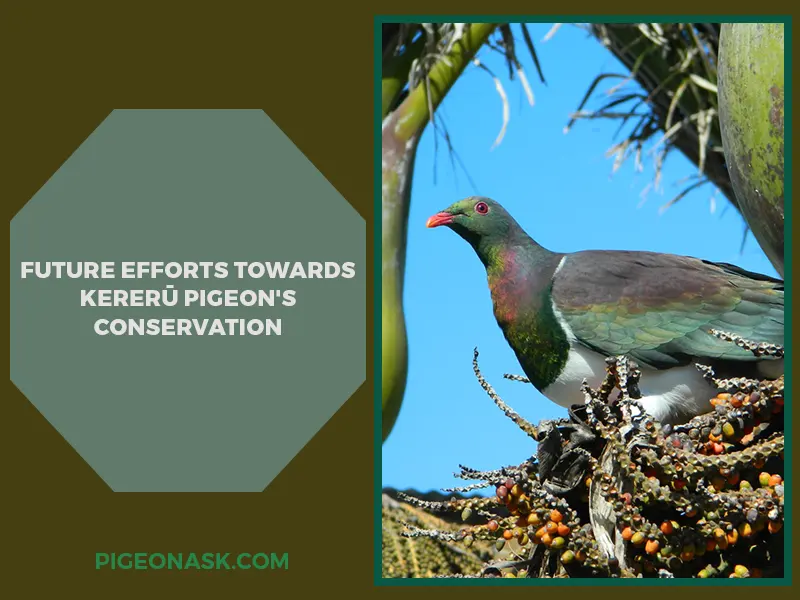
These steps began to take shape as concerns over the declining population grew and awareness of the bird’s ecological importance increased.
It is the only bird left in New Zealand that can disperse the seeds of large native trees such as tawa, puriri and kahikatea.
These efforts are mainly coordinated by various conservation agencies like Government projects, NGOs, community groups and individual initiatives.
DOC of New Zealand Government
Department of Conservation (DOC) in New Zealand is at the forefront of Kererū conservation efforts.
The DOC carries out regular monitoring of Kererū populations and has also embarked on large predator control programs to protect the Kererū from its non-native predators.
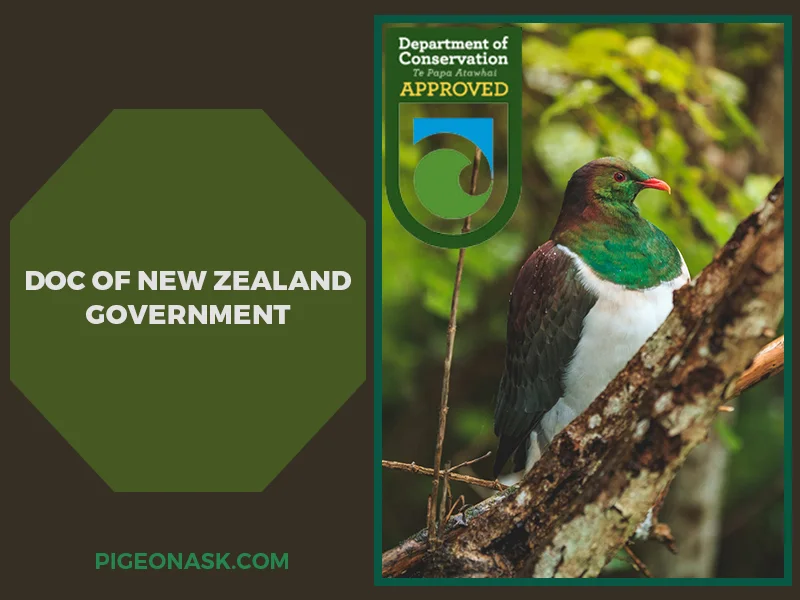
One key conservation effort was the establishment of the Kererū Discovery Project.
Launched in 2005, the initiative aimed to increase the awareness and knowledge about Kererū among New Zealand’s public and encourage them to participate actively in their conservation.
The project enables individuals to report Kererū sightings, which helps in monitoring their population status. This project is supported by The Greater Wellington City Council.
They also initiated ‘Project Kaka,’ an intensive predator control program aimed at enhancing the Kererū survival rate.
The project brought a significant reduction in rats and stoats in the Tararua Forest Park, leading to an increase in the Kererū and some other bird populations.
Growing Food for Kererū Program
The Arbor Day Trust, a nonprofit conservation and education organization and DOC, has also been helping Kererū by planting native trees, providing food for these pigeons and making efforts to spread awareness about their importance to forest ecosystems.
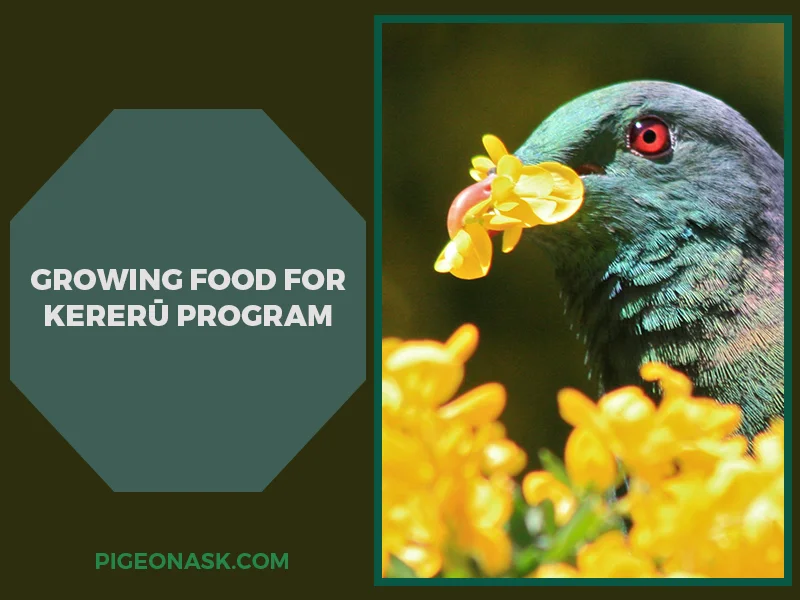
These organizations also provide a kereru-friendly plant list for community activists to plant trees in local parks and also involve the community in activities.
Local communities act in collaboration with scientists and conservationists to create safer spaces for the Kererū. Such as habitat restoration, trapping pests and monitoring their populations.
This effort increases the pigeons’ food availability and their survival in the wild.
Great Kererū Count
The annual Great Kererū Count is New Zealand’s most extensive citizen science project, encouraging people to count and report the number of Kererū pigeons they see.
Plus, the information collected aids scientists in understanding the changes in population trends, distribution, habitat preferences and the impact of conservation actions.
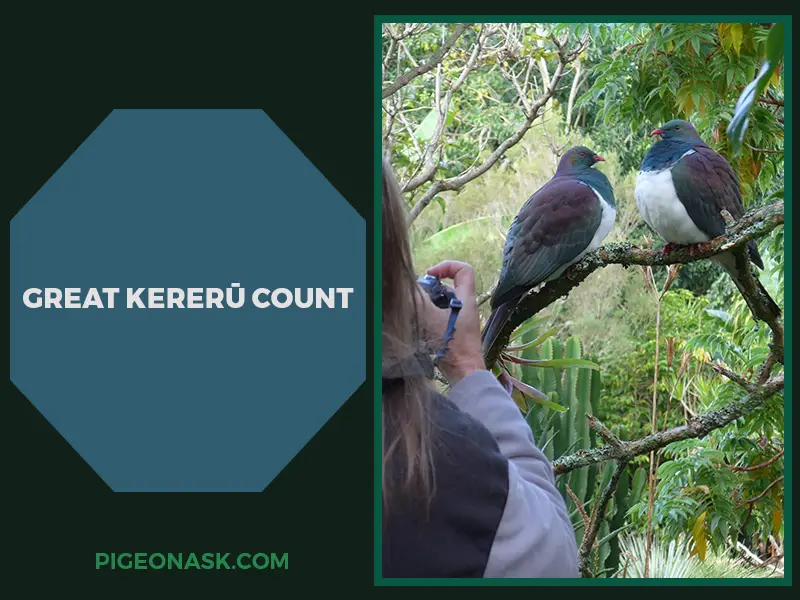
According to the GKC Annual Report of 2021, a total of 24,562 kererū has been counted.
This highest number was recorded using 12,000 sightings report submissions. Indicating a 17 percent rise in sightings from the previous year and a 77 percent increase from 2019.
The future plan for the GKC is to continue engaging the community in conservation efforts, thereby creating a comprehensive and ongoing annual dataset.
And the aim is to help scientists understand more about kererū abundance, distribution, behavior and habitat and to monitor the impacts of threats such as predation and habitat loss.
Laws to Protect the Kererū
The Kererū pigeon is legally protected under the New Zealand Wildlife Act of 1953. This Act makes it illegal to kill or capture any New Zealand native bird, including the Kererū pigeon, without proper authorization.
Furthermore, efforts to secure the pigeons’ habitat include the development of legislation such as the Resource Management Act, enacted to maintain and protect New Zealand’s natural and physical resources.
This Act helps protect the habitats of native birds, including the Kererū pigeon, against urban development and land misuse.
Public Education About the Pigeons’ Role in the Ecosystem
The sustainable conservation of any endangered species depends on public acceptance and understanding.
Recognizing this, conservation groups, governmental departments and educational institutions in New Zealand have put considerable efforts into educating the public about the Kererū pigeon’s ecological significance.
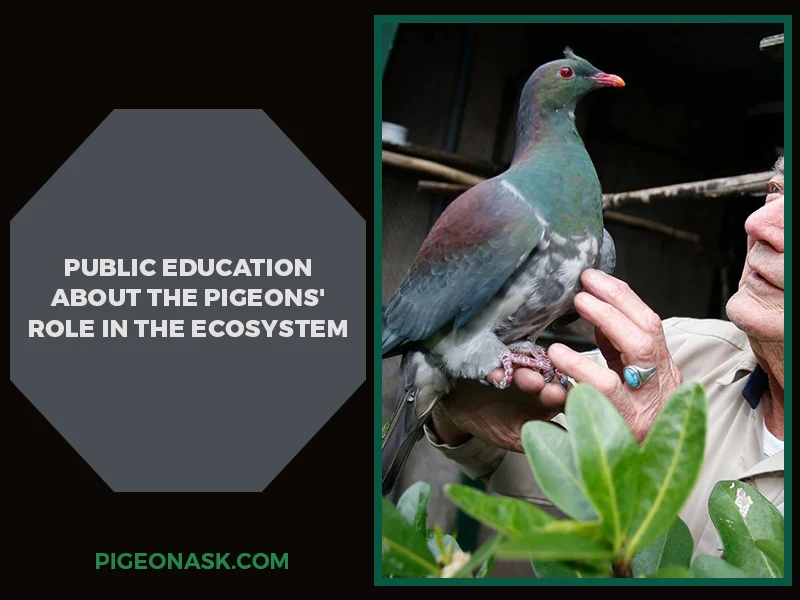
Campaigns like the annual ‘Kererū Count,’ the nation’s biggest citizen science project, encourage locals to record their Kererū sightings.
This creates public participation in bird conservation and enhances awareness of the importance of birds.
Moreover, organizations like Forest and Bird, Kererū Discovery and schools across the country offer educational resources and run programs and workshops.
Which informs the public about the need for the preservation of New Zealand’s native species, including the Kererū pigeon.
Final Words
The return of the Kererū pigeon, an icon of New Zealand’s natural heritage after a 24-year absence, provides a beacon of hope for the conservation community.
This return is a testament to what can be achieved through dedicated conservation efforts.
While the fight to protect New Zealand’s native species continues, this incredible news serves a critical role in raising awareness and hope for other species still struggling for survival.
Even when a species seems to have disappeared entirely from its native habitat, it may still be possible to bring it back, assuming the right conditions are met.
Government bodies, local communities and conservation groups all played pivotal roles in the recovery of the New Zealand pigeon, highlighting the need for continued collaboration in order to protect and restore our natural world.
Kererū’s return home after 24 years is not just a celebration but a wake-up call for us to recognize and respect the significance of every participant in the ecosystem, no matter how inconspicuous.
It’s our responsibility to ensure that such disappearances don’t recur, ensuring that our enlightened actions today can influence the survival and flourishing of countless species tomorrow.
